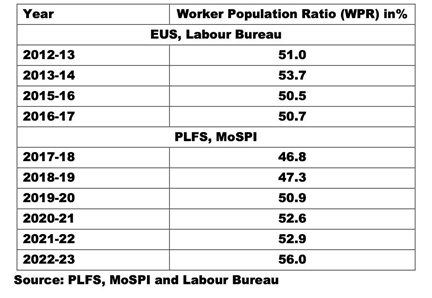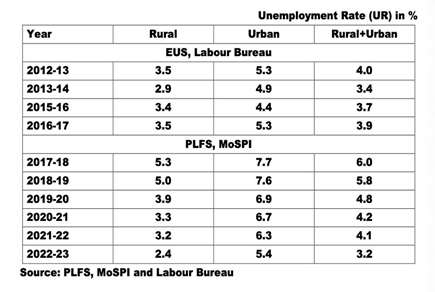On December 4, during the Lok Sabha session of Parliament, questions regarding generation of additional employment opportunities by the government were raised. Two leaders of the Shiv Sena (Uddhav Balasaheb Thakeray), namely Vinayak Raut representing Ratnagiri-Sindhudurg constituency in Lok Sabha and Sanjay Jadhav representing Parbhani constituency in Lok Sabha, had raised the these queries. Through this, they had asked detailed questions regarding the generation of new employment opportunities as well as the state of unemployment in the country.
Bhupendar Yadav, the union cabinet minister for Environment, Forest & Climate Change and Labour & Employment, responded to the question with data regarding jobs and unemployment. The data contained the estimated Worker Population Ratio (WPR) and Unemployment Rate (UR) on usual status for persons of age 15 years and above in the country during the last ten years.
At the outset, it is crucial to point out that the results from both the data provided through PLFS and the Labour Bureau is not comparable due to different sampling methodology and coverage. PLFS covers seasonality of labour force as it is conducted during the period July to June (i.e. full year) whereas field work in Labour Bureau survey varied from 7 to 9 months and therefore, complete seasonality was not covered.
The PLFS data indicates that the unemployment rate in the country has declined to 3.2% during 2022-23 from 6% in the year 2017-18. Further, the data provided showcases that the estimated Worker Population Ratio (WPR) in the country has increased from 46.8% during 2017-18 to 56% during 2022-23. Based on this data, it can be deduced that employment in the country has an increasing trend.
Notably, since the year 2012, fluctuations can be observed with the WPR ratio, especially reducing significantly from 2017 to 2018. Post 2018, the same can be seen as gradually increasing, thereby depicting that the proportion of population is actively contributing to the production of goods and services.
As provided by the union’s data, the unemployment rate reduced gradually from 2013-2017. During the period of 2017-18, a drastic change in the unemployment rate can be observed as it increased from 3.9% in 2017 to 6% in 2018. Pursuant to the same, the unemployment rate can be seen as declining since 2018 to 2023, pointing to a good indicator for the country’s GDP. The said data showcases that employment opportunities are being given to the population of the country.
It is crucial to highlight here that the response of the union government fails to provide the number of new jobs registered by the Government during the last ten years as well as the number of unemployed persons as per official records during the last five years, as was inquired by the Shiv Sena ministers.
Union minister Yadav has provided the details of the development schemes being implemented in the country to boost employment.
The complete answer can be read here:
Related:
Union data shows increasing beneficiaries of scholarships for OBCs in the past 5 years
MOE: Alarming dropout rates among SC, ST, and OBC students in premium institutes of India since 2018
Displacement due to Airport Expansions? Union Response in Rajya Sabha Leaves Questions Unanswered
Over 5 years, 1033 serious coal accidents reported, 717 took place in Telangana alone



